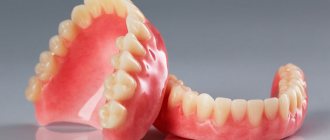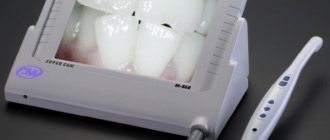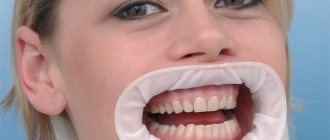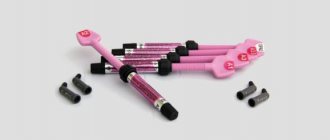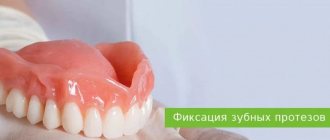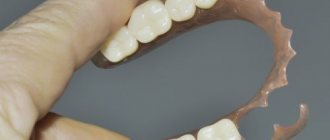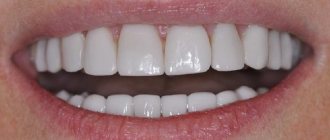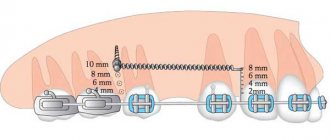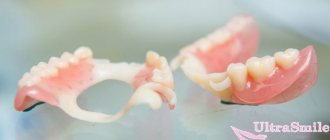Indications for installation
Plastic dentures are necessary to replace all the teeth in the mouth or some of the lost elements.
Indications for installation:
- Complete absence of teeth. In this case, the structure will be attached to the gums due to the vacuum effect. This type of product is called removable suction cup jaws.
- Partial absence of elements. In this case, the devices are attached to the oral cavity using clasps. The structure is supported by its own preserved elements.
- Missing one unit in a row. In this case, dentists advise patients to have a butterfly denture. This system can be used as a temporary replacement for missing teeth until a permanent denture can be made.
Plastic structures are suitable for fixing mobile teeth, masking deformed elements and temporarily replacing missing segments in a row. There are few contraindications for installing plastic structures. The main ones are an allergy to acrylic, a short crown part of the tooth, and various malocclusions.
Difference from nylon models
Many patients are interested in which dentures are better - nylon or acrylic. Indeed, these materials are very common and constantly compete with each other.
They have the following differences:
- Acrylic. It has a solid structure and holds its given shape for a long time. It has a porous composition and is susceptible to the formation of microbes. Releases toxic components during prolonged wear. Can be fixed using special glue. The main advantage of such models is the affordable prices for acrylic dentures.
- Nylon. Soft material that adapts well to the oral cavity. May become deformed over time. Structures made from it are non-porous, so there is almost no plaque or odor on them. The material does not emit toxic substances. As a rule, removable products are fixed due to the suction effect; cream may not be used. Prices for nylon prostheses are quite high.
Types of products
There are several types of systems depending on the production method, the materials used and the method of attachment in the oral cavity.
Structures are made in 2 ways:
- Compression pressing method. Such a product may not be ideally suited to the parameters of the jaw. However, in this case, getting a removable denture is the easiest and fastest way. Disadvantage of the system: long adaptation period, fragility.
- Casting method. With the help of casting, structures that most precisely match the parameters of the jaw are obtained. They imitate the patient’s teeth and gums as accurately as possible.
Based on the method of fastening, plastic products are divided into removable and non-removable. The first type is recommended for complete absence of teeth. Acrylic is usually used to produce a removable jaw.
Partially removable dentures are recommended for patients to temporarily replace elements when installing dentures. Another indication for their installation is partial edentia. Dentists consider plastic structures as a temporary solution to the problem, since the materials used for their production are of low quality and have low performance properties. The procedure allows patients to maintain an attractive appearance until it becomes possible to undergo prosthetics.
Butterfly prosthesis
Dental plastic or acrylic is most often used in the production of dentures. However, other, more modern materials are also used:
- Ethacryl. It has better strength and performance characteristics compared to acrylic.
- Bicryl. It is resistant to mechanical stress. Does not crack or sag when consuming hard foods.
- Ftorax. It is a translucent material that is invisible in the mouth.
- Acree Free. Made from acrylic resins. It is hypoallergenic due to the absence of monomers in its composition.
The latest development - Vertex
Not long ago, the semi-rigid Vertex design was developed, which has already received many positive reviews. The following features can be highlighted:
- The material is characterized by high density and exceptional smoothness.
- The chewing load is evenly distributed on the upper and lower jaws of the product.
- The design is resistant to temperature changes and retains its shape even when eating very hot food.
- The prosthesis does not change color and does not absorb any odors.
- The product does not emit harmful substances and does not contain monomers.
- The models are very resistant to mechanical damage.
Vertex models look like this:
Acrylic
Partially removable
Partially removable
Telescopic and on implants
You can make the design in any of 12 shades:
Prosthesis manufacturing technology
Before installing the prosthesis, the doctor examines the patient’s oral cavity and identifies any contraindications to the procedure. After this, the person is sent for an x-ray to identify the location of the roots of the remaining teeth. Those elements that cannot be restored using conservative techniques must be removed.
Prosthetics are not performed even if there are tumor-like formations in the soft tissues of the mouth. Procedures are prescribed only after removal of the seal (alveolectomy).
The production of a removable denture from acrylic plastic occurs in several stages:
- Grinding of supporting teeth. The procedure helps prevent negative consequences associated with contact between enamel and plastic. The duration of the work ranges from 40 minutes to 3 hours, depending on the specifics of the procedure.
- The dentist takes an impression of the patient’s teeth and sends it to the laboratory for further fabrication of structures. The height of the bite is determined using wax rollers for 15-20 minutes.
- In the laboratory, a wax model of future dentures with artificial teeth implanted into it is recreated.
- After making the model, the orthopedist tries it on the patient's jaw.
- At the last stage, a plastic denture is made. After installation in the oral cavity, the structure is polished and ground. The color of the enamel is selected by the doctor during the clinical stages of treatment.
The injection molding method and pressing have similarities in preparatory activities. In each case, a preliminary formation of a three-dimensional model of the patient’s oral cavity occurs.
For better fixation of the product in the oral cavity, patients are recommended to use special glue. The substances are used once a day: they are applied in a thin layer to the surface of the material in those places where it comes into contact with the gums. At night, the product is removed, and the remaining adhesive is removed.
The choice of a suitable composition is important for reliable fixation of the structure. The degree of patient comfort when wearing a prosthesis depends on the correct decision. Before giving preference to one or another product, you need to pay attention to the following nuances:
- The glue must retain its effect for at least 12 hours. Otherwise, the application procedure will have to be repeated several times a day.
- The paste should be of medium consistency. Liquid glue will spread over the denture, and solid glue will be noticeable in the oral cavity when you smile.
- Preference is given only to pharmaceutical products. Adhesive obtained from hand can cause swelling and redness of the soft tissues of the mouth.
List of popular denture creams:
- Protefix;
- Lakalut;
- Corega.
Popular adhesive for dentures
Pros and cons of dentures
Among the positive characteristics of plastic dentures, the following should be noted:
- accessibility to wide sections of the population;
- colorlessness, making dentures similar to natural teeth;
- invisibility of the product while smiling;
- speed of production in contrast to metal-ceramics;
- Possibility of installation in 1 visit to the dentist;
- the ability to select a design of any color, shape and size.
Which dentures are best for teeth?
Like other dental structures, plastic dentures have their disadvantages:
- short service life (less than 5 years);
- the likelihood of developing allergic reactions to acrylic;
- the appearance of bad breath due to insufficient care of the structure;
- the possibility of damage to the soft tissues of the mouth due to the large area of contact of the prosthesis with the palate;
- loss of taste of consumed products due to the product blocking taste buds;
- inability to chew hard foods;
- the need for constant visits to the doctor to assess the condition of the prosthesis.
Due to the porous structure, the color of the prosthesis may change, so when wearing it, it is better to avoid coloring products (juices, soda, coffee, tea), so that the material retains its appearance for as long as possible, it is necessary to give preference to high-quality metal-plastic.
Structural materials in prosthetics
A modern dentist has a sufficient amount of materials for making dentures in his arsenal.
In modern prosthetics, materials such as: Plastic are used. Used for the manufacture of temporary crowns, and removable acrylic and nylon structures. Plastic products do not last long, so they will need to be replaced after a while.
Metal. Gold-containing and cobalt-chromium alloys are widely used. Metal crown frames and clasp dentures are very common.
Zirconium. Zirconium oxide and dioxide are ideal materials for restoring dentition in the chewing area. The ceramic coating of zirconium crowns gives the product a natural shine.
Ceramics. This material is valued for its properties that are as close as possible to natural tooth enamel. For ceramic products, you can easily choose the desired shade. The main disadvantage of ceramics was previously considered to be low strength, but with the beginning of the use of sodium disilicate in prosthetics, this parameter improved. A good example of the use of ceramics is E-Max crowns.
Which dental prosthetics is better and cheaper is a question that only his attending physician can answer for each patient. Much depends on the location of installation - anterior or chewing teeth, the level of qualifications of the specialist and the nuances of a specific clinical situation.
Product care
To increase the life of artificial teeth, you need to follow certain rules for caring for them. It is important to clean the structure from food debris and plaque in a timely manner to prevent bad breath and the development of dental diseases. Patients wearing plastic prostheses must:
- Clean the product daily using a brush and paste;
- after eating, remove the device from the mouth and rinse under running water;
- do not remove the structure at night during adaptation;
- do not store artificial teeth without a special solution;
- For care, use special tablets and pastes.
Cleaning the prosthesis
Question-answer section
What is the maximum service life of dentures?
Experts say that the average service life of the device is 3 years, but with good care you can increase the service life to 5 years. If there is even the slightest damage to the plastic, you should immediately contact the clinic for restoration work.
Removable teeth are also sent for repair if the functionality of the locks is impaired or the initial shape of the arch changes. The price for repairing the product depends on the complexity of the dental work and the size of the structure.
Why does plastic turn dark?
The problem occurs due to the roughness of the material. The porous structure is maintained even after polishing and grinding the linings. Because of this, food and dye residues accumulate on the surface of the prosthesis. Structures lose their original appearance due to plaque.
How to whiten a denture?
The removable jaw is effectively cleaned using abrasive compounds. To do this, you can use special powders or regular baking soda. The procedure should not be repeated too often, as the abrasive components leave small scratches on the product. Because of this, even more plaque accumulates on their surface.
How to clean dentures?
Pharmacies sell many products designed for cleaning and whitening removable jaws. They are usually sold in tablet form to be dissolved in water. The product is immersed in a disinfectant liquid overnight. The most popular manufacturers of tablets for cleaning dentures: Dental, White, Corega, President. Such cleansing is carried out once every 7 days. The procedure gives the structures their original appearance and prevents the proliferation of pathogenic bacteria on their surface.
How is professional whitening of artificial teeth performed?
If home care methods for the device do not produce results, you should contact the clinic for a professional cleaning procedure. This service is provided by almost all dental institutions. In a clinical setting, the prosthesis is polished to reduce contamination later.
Patient reviews
Oksana, Tver. The doctor recommended prosthetics with plastic structures to me after I lost 1 tooth, visible when I smile. There was no money for implantation, so I was recommended an alternative way to restore a lost tooth - a butterfly denture. The cost of the design is only 15,000 rubles. The product is invisible when worn. At night, remove the structure and clean it with a brush and special paste. People around me don’t notice that one of my teeth is not real.
Kostya, Samara. Since I was young I have had problems with my teeth and regularly see the dentist. After the teeth began to loosen, the doctor suggested installing a self-adhesive plastic denture. At first it was unusual to talk and eat solid food, so I took all meals only in crushed form. I was able to return to my previous diet after 3 weeks.
Anton, Perm. After a maxillofacial injury, my 3 front teeth were removed. This situation caused my discomfort in front of others. After some hesitation I made a choice in favor of a plastic bridge. The product was manufactured in a short time, but after its installation I felt significant discomfort while talking and eating. Another unpleasant problem was that the prosthesis constantly rubbed the gums. I had to go back to the clinic to have the product corrected. It’s been 2 years now and now I wear the prosthesis regularly, taking it off only at night. I don’t feel the same discomfort from wearing it.
Factors influencing adaptation time
The individual characteristics of a person, his psychotype and desire, influence how quickly he can get used to removable dentures.
Other factors include:
- How well the design fits in the mouth. If the restoration does not adhere well to the palate, it causes constant discomfort. It is difficult to get used to such a prosthesis. It shrinks and damages the mucous membranes.
- Is there any pain? It's hard to feel like your artificial jaw is yours when you're constantly in pain.
- Prosthesis design. It is easier to get used to clasp dentures than to plate dentures. It will take longer to get used to the upper denture.
- Quality of manufacture of dentures. The gag reflex will not go away if the distal (back) edge is too long and irritates the palate. A poorly fitted restoration rubs the gums and causes discomfort when chewing. This design needs correction.
Getting used to removable dentures occurs much faster if the denture is not your first. Usually it takes 3-5 days
.
